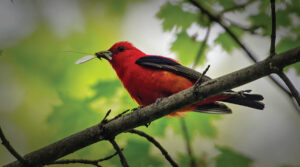Let’s Go Bird Watching

By Alexis Bohlinger
Macomb County is a hidden gem for natural beauty in Michigan with its vast lakes and rivers creating a diverse ecosystem of wildlife. With all of its natural habitats, bird watching has become one of the fastest-growing hobbies in the area and continues to grow with the inception of live maps, websites and resources to track each species and their flight patterns. Macomb and St. Clair counties partnered to create a website, scmbirdtrail.org, a live map and signage for the St. Clair-Macomb Birding Trail. The website went live one year ago on Audubon Day, April 26, and it has increased both knowledge and popularity of birding in the area.
 “We consider ourselves very fortunate to live in an area with such incredible wildlife assets that draws people from all over North America for viewing and photography!” said Gerard Santoro, program director for Macomb Parks and Natural Resources.
“We consider ourselves very fortunate to live in an area with such incredible wildlife assets that draws people from all over North America for viewing and photography!” said Gerard Santoro, program director for Macomb Parks and Natural Resources.
According to longtime member of the Audubon Society Barb Baldinger, bird watching has been one of the top hobbies in the US for years and became even more popular during the Covid pandemic. “People can either observe from their home feeders or go out to different locations marked with signage and watch for the birds.”
There are a number of resources that people can use to learn about and track these species, in addition to scmbirdtrail.org. One of the biggest sources for choosing the locations for the St. Clair-Macomb Birding Trail was ebird.org, an online database of bird observations providing scientists, researchers and amateur naturalists with real-time data about bird distribution and abundance.
Many have been able to discover new birding areas thanks to the paper map guides and signs, all of which have a QR code that directs people to the website for more information.
Baldinger believes that the increasing interest in birding will spread awareness and support for these natural bird habitats. “I think with more knowledge and resources, people will be more likely to join local Audubon groups, donate to bird conservation organizations, and also become more aware of yearly bird surveys, such as the Great Backyard Bird Count and the Christmas Bird Count, both of which supply data on how to support species in the wild.” She continued, “The nice thing about birding is you can enjoy it at many different levels. Some people are happy watching the red, blue or yellow birds at their feeders and others know the names of the species, their songs and calls, and where to find them. People will travel to see species that are not normally found in their area and keep lists of all of the bird species that they have seen.”
With all the bird watching going on, it’s also important to consider a bird’s habitat. All of us who reside here can bring better living habitats for our birds in our own backyards. And since cities and suburbs are taking over our farmlands, creating gardens and vegetation that birds need for food and shelter is more important than ever. Birds need shelter, such as shrubs and trees, to hide from danger, including hiding from larger birds like hawks who prey on small birds. If you have bird feeders, having shelter close by will provide a more welcoming area for birds to come. Providing native plants, shrubs and trees with natural sources of berries, seeds and nectar is important. Plants like arborvitae, dogwood, holly and lilacs are just a few that birds will flock to. Trees like American elm, black cherry and a variety of oak species are trees birds spend time in foraging. Beyond food and shelter, birds also need water for drinking and bathing; providing bird baths gives them options beyond our rivers and waterways.
Why should we do all this for the birds? Because our ecosystem needs a variety of birds to thrive. Birds eat insects, 400- 500 tons per year. They disperse seeds, spreading plants to new areas and help pollinate. Doing all this not only brings us more birds to watch and enjoy, it keeps our ecosystem strong.

